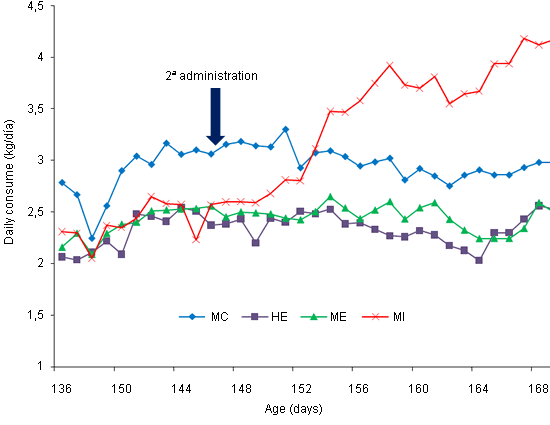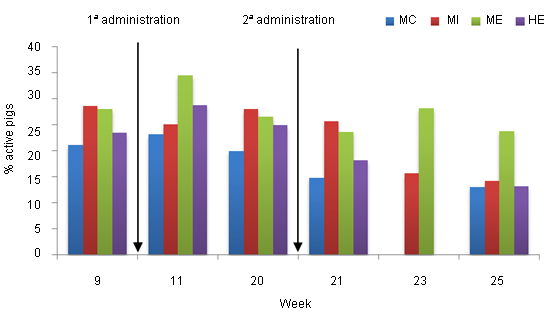120 piglets, crosses between hybrid Duroc x Landrace sows and Pietran boars with homozygous recessive halothane genes (nn) were used: 36 uncastrated males (ME), 36 uncastrated males to be immunized later (MI), 24 castrated males (MC) and 24 females (HE). The pigs from each treatment were placed in corrals, able to hold 12 animals, with maximum weight uniformity. Productive control was initiated after 74 days of life, and ended at approximately 176 days. The 36 MI were given 2ml dose of the injectable vaccine, with 200 µg of GRH protein/ml in a liquid suspension, at the age of approximately 77 days old and 146 days old. The productive variables considered were individual weight and fat and loin thickness, measured with ultrasounds every three weeks, as well as daily consumption, registered by automatic feeding stations. This way, aggressive sexual activity and behavior was registered in the 12 pigs housed in a corral for each treatment. The patterns of conduct considered were activity/inactivity (which was noted for each animal every 5 minutes during 3 periods of observation lasting 2 hours each), as well as all aggressive or sexual interactions (which were observed continually for 10 minutes in each period).
In table 1 the main productive results of the study can be seen. The MI presented a growth and daily consumption greater than that of the ME, but their conversion indexes did not vary significantly. As far as the MC go, the MI showed a better conversion index, but their daily consumption and growth and their final weight weren’t significantly different. The final fat thickness of the MI was less than that of the MC, but higher than that of the ME (12,84, 14,79 and 9,80mm, respectively).
Table 1. Productive means of the variables evaluated for barrows (MC), immunized males (MI), males (ME) and females (HE)
| MC |
MI |
ME |
HE | |
| Live weight (kg) | ||||
| Start weight (kg) | 29,46 | 28,13 |
27,08 |
27,36 |
| Weight at V2 (kg) | 85,63b |
87,67ab |
87,19ab |
89,56a |
| Weight at the end (kg) | 119,09a |
122,74a |
111,97b |
108,76b |
| Daily gain (g/day) | ||||
| Start at V2 | 928,16a | 840,76b | 836,46b | 869,26ab |
| V2 to slaughter | 844,97b | 1160,04a | 825,32b | 679,71c |
| Global | 898,32a | 936,55a | 835,68b | 802,93b |
| Daily consume (g/day) | ||||
| Start at V2 | 2136,72a | 1761,95b | 1773,96b | 1873,37b |
| V2 to slaughter | 2894,76b | 3446,65a | 2486,55c | 2417,69c |
| Global | 2482,61a | 2355,57a | 2071,33b | 2096,76b |
| Conversion index |
||||
| Start at V2 | 2,31a | 2,10b | 2,12b | 2,16b |
| V2 to slaughter | 3,43a | 2,98b | 3,20b | 3,78a |
| Global | 2,76a | 2,51c | 2,48c | 2,48c |
Its worth mentioning that, coinciding with the results presented in other studies, the effects of immunization were more evident afterthe second dose was admnistered. This phemnomenae can be clearly observed in figure 1 which represents the evolution of consumption. It is considered that the MI behave like uncastrated males until the second dose of the product is administered and that, somehow, the potential anabolic know to exist in uncastrated males, in relation to the castrated ones, is less beneficial to the MI up until this point.
Figure 1. Evolution of the daily consume in the different genres during the last phase of fattening.

The patterns of conduct observed coincide with the productive data, so much so that the MI showed a decrease in their activity compared with the ME, especially after the administration of the second dose (figure 2). The number of aggressive attacks in the trough area as well as in other areas was higher in the ME than in the others. The number of mounts was higher in the ME than in the MI, especially two weeks after the administration of the second dose (6,5 vs 1,5, respectively). Sexual and aggressive behavior is influenced by the gonad steroids, and their inhibition after surgical castration as well as after GRH immunization, would explain these results.
Figure 2. Percentages of activity during the evaluated period.

In conclusion, the productive and behavioral results found in this study suggest that GRH immunization is an alternative to surgical castration. The MI conserved the benefits of the ME up until the administration of the second dose of the product, in such a way that their conversion index was better than that of the MC.- Activity and percentage of mounts and attacks were reduced after immunization, especially after the administration of the second dose.




